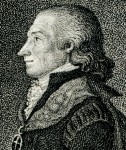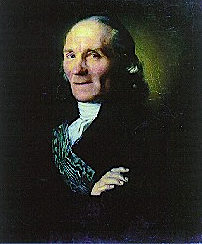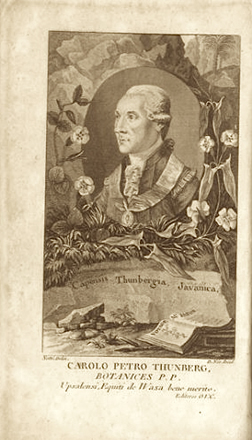|
Date of Birth |
11 November 1743. |
Place of Birth 
|
Jönköping, Småland, Sweden.
|
|
Date of Death |
8 August 1828. |
Place of Death 
|
Uppsala, Sweden. |
Monuments Medals Etc. 
|
- Yes.
- Thunberg’s memorial stone, Uppsala churchyard.
- Memorial monument in Nagasaki, honouring E. Kaempfer & C. P. Thunberg, erected by Siebold 1826.
- Medallion with Thunberg’s portrait, dated 1818. Uppsala University.
- The Royal Swedish Academy of Sciences’ memorial coin from 1832 as a memory of Thunberg.
|
|
Variations of Name's Spelling |
First name sometimes
Karl Petter.
|
|
Preserved signature |
In correspondence.
|
|
Portrait |

Portrait of Carl Peter Thunberg; German etching, published in ‘Journal für die Botanik’,
Vol. 1. in Göttingen 1799.
[Source; Jens Hansen/The Library, The IK Foundation & Company, United Kingdom].

Oil on canvas by Per Krafft the younger c. 1808. Thunberg
depicted as a 65 year old man. Uppsala University,
and another copy at The Royal Swedish Academy of Sciences,
Stockholm.

Copper plate by S. Westermayr, undated. The plate
shows Thunberg in his 40s, during the 1780s.

Copper plate of Thunberg depicted in full figure at his
visit in Edo, Japan 1776, dressed in braided gallooned
dress with sword.

Portrait bust of the same engraving as the above mentioned
depiction from Edo 1776, but on this portrait
Thunberg is surrounded by mountains, trees and flowering
plants. The portrait can be seen in the French edition
from the 1790s of Thunberg’s travel journal.

Bust by Göthe of Thunberg as an elderly man (made
from his death mask). Uppsala Botanical museum.

Portrait of Thunberg, added with his signature and a
dedication to a student on the 12 December 1816. The
Latin text, translated into English; “Trust God and He
will uphold you, when you least expect it”. The portrait
was published in the paper ‘Magasin för Konst, Nyheter
och Moden’. Tidningsskrift, 5, Stockholm 1828.

Etching based on Pehr Krafft the younger’s oil on canvas
from c. 1808, published in ‘Svenskt Pantheon’, Stockholm
1832. (This is one of several etchings based on
Krafft’s painting).

Portrait of Carl Peter Thunberg by Jacob Fredrik Ek, circa 1820-25. Vetenskapsakademiens porträttsamling. Public Domain. |
|
Childhood, Adolescence & Education |
- Father, bookkeeper and shopkeeper Johan Thunberg.
- Mother, Margaretha Starkman.
- Carl Peter’s father died when he was seven and his mother carried on the work with the family’s shop. She remarried 1753 with Gabriel Forsberg, also he a shopkeeper.
- Thunberg started school in a so called apologist class in Jönköping.
- He progressed to the trivial school in Jönköping at the age of 12, alongside private tutoring.
- Student, Uppsala University 1761. He introduced his studies with theology and philosophy and continued with medicine and chemistry to a total of nine years. He was most interested in natural history and medicine, studied under Linnaeus.
- Defended his medical thesis ‘De venis absorbentibus’ 1767.
- Graduate in Medicine 1769.
- Bachelor of Medicine 1770.
- Thunberg defended a doctor’s thesis in medicine on sciatica 1770.
- He was conferred to Doctor in Medicine in his absence, 1772. (Thunberg had started his nine year long journey 1770).
|
|
Professional Life |
- Thunberg’s professional life started with a nine year long scientific journey between the years 1770-1779. (See, ‘Journeys and Voyages’).
- Thunberg returned to Uppsala 1779, where he continued to work for the rest of his life. Much had changed at his return home, especially that Carl Linnaeus had passed away the year before. Thunberg entered upon the employment as “botanices demonstrator”, and was appointed Professor in botany 1781.
- 1784, Thunberg was appointed the botanical professor’s duty “the Chair of botany” after Linnaeus’ son Carl Linné the younger, an employment Thunberg kept for the rest of his life (1828).
- 1785, Thunberg donated all his natural history collections to Uppsala University.
- Thunberg also established a new botanical garden in Uppsala with the support of King Gustav III, and additionally founded a new building for a museum, opened 1807. Thunberg’s own herbarium is kept here, besides other collections.
- Thunberg was during his lifetime honoured to become fellow of c. 65 learned societies, in Sweden as well as other countries.
|
Journeys & Voyages 
|
- Thunberg started his long journey on the 13 August 1770. He travelled by land from Uppsala to Helsingborg in the south of Sweden where he took a boat to Copenhagen and continued toward Amsterdam. (This part of the journey was financed with a scholarship).
- He arrived to Amsterdam in October 1770, where he stayed for a year with the botanists Johannes and Nicolaas Laurens Burman, Thunberg’s work here was primarily to examine plants and cataloging. The botanists understood quickly that Thunberg was a very competent botanist and decided to send him on a longer botanical journey with a Dutch East India Company ship. During his period in Holland, Thunberg also made a trip to Paris to study the practise of medicine.
- The next part of Thunberg’s travels included a voyage to Japan - for that reason he had to ‘appear as Dutch’ and learn the language as they were the only Europeans who could entry the country. The language practise took its place in the Dutch colony of Cape, so Thunberg sailed with a Dutch East India Company ship on the 30 December 1771 towards Cape and arrived three and a half months later. (His journey was from this point financed by the Burmans in Amsterdam and other Dutch sponsors, at the same time as Thunberg helped out as assistant surgeon during his travels on the different East India ships. However, he also had to borrow money at several occasions during his time in Africa to be able to fulfill his botanical assignments).
- Thunberg stayed in Cape and performed three longer journeys inland and along the coasts to study natural history, 11 April 1771 to 2 March 1775.
- He sailed towards Java on the 2 March 1775 and arrived 18 May to Batavia, where he stayed for a month before continuing his journey with the Dutch East India Company to Japan, where he spent fifteen months studying flora and making other observations. On his return from Japan he first made a stop for half a year at Java and here after for a similar period at Ceylon, what is now known as Sri Lanka. His journey back to Europe started 6 February 1778 towards Cape, after a shorter stay in Africa, the ship sailed towards Texel in Holland and arrived here 1 October the same year. Before Thunberg returned to his home country, London was visited during a few months, from here the journey continued via the Netherlands, Germany and arriving at the southernmost part of Sweden in Ystad on the 14 of March 1779. He is considered to have been the greatest botanist of his day and organised large collections from a number of European countries.
|
Travel Diaries & Other Publications in Connection with the Journeys & Voyages 
|
- His travel diaries were published in four languages between 1788 and 1796. Resa uti Europa, Africa, Asia, förrättad åren 1770-1779. Vol. I 1788, Vol. II 1789, Vol. III 1791, Vol. IV 1793.
- Flora Japonica, 1784.
- Flora Capensis, Vol. I. 1807-1813 and Vol. 2. 1818-1820, complete edition (by J.E. Schultes) 1823.
- Tal om Japanska Nationen, hållet för Kongl. Vetenskaps Academien. Praesidii-Tal i Kongl. Vetenskaps Academien, 1784. (Printed speech held at The Royal Swedish Academy of Sciences related to Thunberg’s journey to Japan).
- Thunberg also published a very substantial amount of small theses after his long journey, foremost concerning observations relating to natural history matters in Japan, Africa, Java and Sri Lanka.
|
|
Civil Status & Family |
- He married Birgitta Charlotta Ruda, 1784.
- The couple had no children of their own, but adopted two children and Carl Peter also took a third foster-child after his wife’s death 1813.
|
Preserved Collections & Manuscripts 
|
- Collection of “Thunbergiana”; 26 boxes with notes, manuscripts, papers, copies etc. relating to scientific work during Thunberg’s life. Uppsala University Library.
- Carl Peter Thunberg’s microscope, purchased by Adam Afzelius in London for £21, 11 May 1790. Uppsala University, Institution for Systematic Botany.
- Extensive collections of letters; Uppsala University Library, Thunberg’s letter collection and The Royal Academy of Sciences, manuscripts and letter collections in Stockholm.
- Thunberg’s extensive natural history collections; 27.500 plant specimens, 25.000 insects, 6.000 molluscs and shells, 300 mammals, 1.200 birds etc. Uppsala University, Museum of Evolution and Zoological Museum.
- Duplicates from Thunberg’s natural history collection can primarily be found in; The Swedish Museum of Natural History and Bergius herbarium both in Stockholm, The Swedish high school herbaria in Karlstad, Linköping and Skara, the Acharius and Retzius herbaria in University of Lund, The Natural History Museum in London, Conservatoire botanique in Geneva, Sonder and Lehmann herbaria in Melbourne University, The Botanical Museum in Helsinki and The Linnean Society of London.
- Two weapons once belonged to Thunberg; no. 150. flintlock gun 18th century, with inscription on the barrel, “C. P. Thunberg” and on the lock “Nortelie” and no. 151. broad-axe with pistol, flint-lock. Museum Gustavianum in Uppsala.
- Ethnographical collection c. 100 items as Thunberg collected during his stay in Japan. Museum of Ethnography, Stockholm.
- Coin collection, Monetary Museum, Stockholm.
- “Descriptions of five plants..., Beskrifning på et nytt Örtegenus, kalladt Rademachia..., Genera nova Capensia..., Diagnoses of plants sent with letters to Linnaeus..., brevväxling”, manuscripts by Thunberg, The Linnean Society of London.
- Letters, The Linnean Society of London, Linnean Correspondence.
|
|
Extra Notes |
- Thunberg stands out as one of the most productive scientists of the 17 apostles, as well as he systematically organised his extensive collections to posterity.
- For the reason of his significant contributions to natural history and particularly in botany, he has been named “The Father of South African botany” and “Japan’s Linnaeus”.
- A notable number of plants and insects have been named after Carl Peter Thunberg, for example; the plant genus Thunbergia Retz. with about 200 species, hundreds of plants named thunbergii or thunbergianuas and many animals, i.e. the northerly species of yellow wagtail Motacilla flava thunbergi and a Japanese butterfly Papilio memnon thunbergi Siebold.
|
|
Added Knowledge |
Discover... |












 The Thora Ohlsson Foundation, Lund, Sweden
The Thora Ohlsson Foundation, Lund, Sweden
 The Thora Ohlsson Foundation, Lund, Sweden
The Thora Ohlsson Foundation, Lund, Sweden











